History and description
The palace is named after Ludovico Acerbi, a Milanese senator, who bought the building from the Rossi di San Secondo family. More than for the appearance of the palace, relatively sober compared to certain exuberances of Baroque architecture, the building is famous for its owner: Marquis Acerbi. In the years when the Manzonian plague was raging, the marquis loved to organise sumptuous parties and go around the city with a carriage and dozens of servants in green livery: Acerbi's exuberance, combined with the fact that none of the numerous guests at his parties ever fell ill with the plague in a period that saw the population of Milan halved, led to the belief among the population that the marquis was the reincarnation of the devil. [1] All this despite the fact that at the outbreak of the epidemic the marquis Ludovico Acerbi had already been dead for years.
The palace presents itself as a regular and austere structure when compared to the Baroque style of the time. The only clue to this style are the curved balconies of the first floor windows, decorated only with bare rectilinear frames, and the lion heads decorating the otherwise equally bare portal. The interior is different: Marquis Acerbi was the protagonist of a challenge with the Annoni family, owners of the palazzo di fronte, for who owned the most sumptuous palace. A cannonball dating from the five days is still visible in the palace, embedded in the façade, to the right of the first right-hand balcony on the first floor, under which there is a small plaque. [2] [3]

Villas and palaces in Milan are used to indicate public and private buildings in Milan of particular artistic and architectural value. Milan has always been an important centre with regard to the construction of historical villas and palaces, ranging from the Romanesque to the neo-Gothic, from Baroque to Rococo.

The Ca' de Sass is a monumental 19th century building in Milan, Italy, located close to the city centre, at numbers 6 and 8 of Via Monte di Pietà. It used to be the headquarters of Cariplo, a former Italian bank, now merged into Intesa Sanpaolo.

The Palace of the Banca Commerciale Italiana is a historic building of Milan, Italy, located in Piazza della Scala, in the city centre. It was designed by architect Luca Beltrami in the early 20th century for Banca Commerciale Italiana, and it is still in use as a seat of the company. Since 2011 it hosts the Gallerie di Piazza Scala where are exposed many artworks from the collections of Fondazione Cariplo.
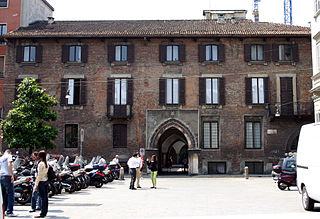
Palazzo Borromeo is a 13th-century building located at street #12 of Piazza Borromeo in Milan, region of Lombardy, Italy,. It stands across a small piazza from the church of Santa Maria Podone and a statue dedicated to the 16th-century archbishop and cardinal, St Charles Borromeo.

Casa Campanini is an art nouveau building in Milan, Italy, located at 11, Via Bellini. It was completed between 1903 and 1906 by architect Alfredo Campanini, who later inhabited the building.

Castello Cova, also known as Palazzo Viviani Cova is a landmark Neo-Gothic style residential and business building located on Via Giosuè Carducci #36, in central Milan, region of Lombardy, Italy. It is located some 100 meters west of the Basilica of Sant'Ambrogio. The building was designed by architect Adolfo Coppedè. Adolfo's career is also noted for designing the Casa del Fascio in Signa, and he was never shy to indulge in the appropriation of former styles and symbols; this building notable for its height and accumulation of Gothic architecture motifs such as a merlionated tower, peaked and rusticated ground-floor arches, and mullion-windows. It sports numerous decorated balconies on the facade.

The Palazzo Brentani is a monumental Neoclassical palace, located on Via Manzoni #6, in the centre of Milan, region of Lombardy, Italy. Both this palace and the adjacent Palazzo Anguissola have sober academic facades, designed by Luigi Canonica in 1829.

The Palazzo Belgioioso is a palatial residence in the northern Italian city of Milan, completed in 1781 in a Neoclassical style by Giuseppe Piermarini.

The Palazzo Anguissola or Anguissola Traversi is a palace located at Via Manzoni number 10, in central Milan, a city in the northern Italy. Construction began in 1778, and its Neoclassical facade, designed by Luigi Canonica, was added in 1829.

Palazzo Arese was a 16th century baroque palace and seat of a branch of the House of Arese in Milan, Italy. It was located adjacent to Casa Fontana Silvestri near the Porta Orientale. The palazzo was demolished in 1943 following damage sustained during the bombing of Milan in World War II.
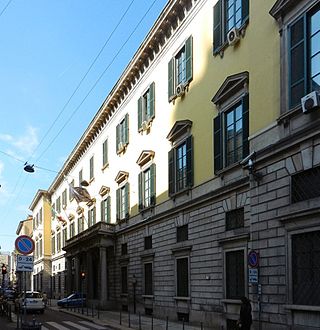
The Prefecture, Milan, also known as Palazzo Diotti, is a historic neoclassical building which has been the location of the office of the Prefect of Milan since 1859. The building is situated at 31, Corso Monforte in the city.

The Palazzo del Monte di Pietà is a 15th-century palazzo in Milan, Italy, adapted in a neoclassical style in the 18th century by Giuseppe Piermarini. Historically belonging to the Sestiere di Porta Nuova, it is located in Via Monte di Pietà no. 5, and was the seat of the Monte di Pietà di Milano.

The Palazzo di Prospero Visconti' is a 16th-century palace in Milan. Historically belonging to the sestiere di Porta Ticinese, it is located in via Lanzone 2, in the ancient contrada del Torchio no. 2,919.

Palazzo Isimbardi, also palazzo della Provincia, is a historic building in Milan located at 35 Corso Monforte, the seat of the Metropolitan City of Milan.
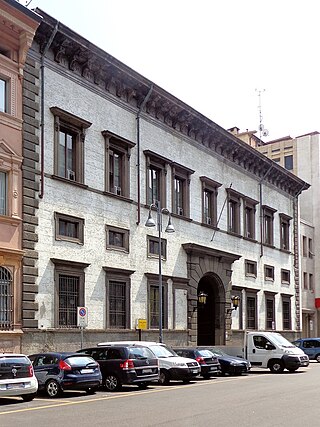
Palazzo Spinola is a 16th-century palazzo in Milan, heavily remodelled during the 19th century. Historically belonging to the sestiere di Porta Nuova, it is located at 10 Via San Paolo. Since 1808 it has been the seat of the Garden Society.

Palazzo Visconti di Grazzano, also known as Palazzo Visconti di Modrone or Palazzo Bolagnos, is a historical palace located in the centre of Milan, in Via Cino del Duca no. 8.
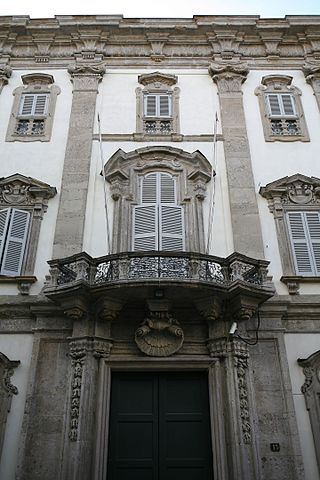
Palazzo Cusani is a 17th-century palace in Milano, remodelled a first time between 1712 and 1719 and a second time between 1775 and 1779. Historically belonging to the sestiere of Porta Nuova, it is located at via Brera 13–15.
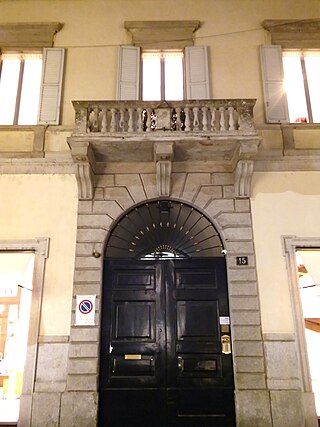
Casa Crespi is a historic building in Milan located at 15 Via Sant’Andrea.
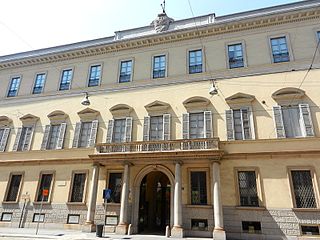
Palazzo Borromeo D’Adda, is an 18th-century palazzo in Milano. Historically belonging to the sestiere di Porta Nuova, it is located at via Manzoni no. 39/41.
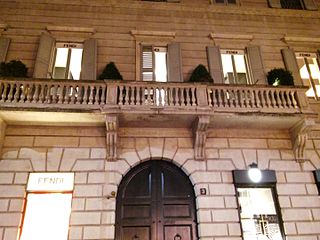
Palazzo Carcassola Grandi is a historical palace in Milan located at via Monte Napoleone 3.





















